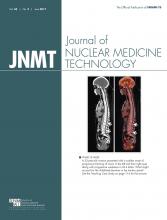TO THE EDITOR: I read with great interest the recent article in Journal of Nuclear Medicine Technology by Bauer et al. entitled, “Do Gadolinium-Based Contrast Agents Affect 18F-FDG PET/CT Uptake in the Dentate Nucleus and the Globus Pallidus? A Pilot Study” (1). The authors’ initial idea of visualizing the functional effect of gadolinium deposition in the brain by 18F-FDG PET is quite smart. However, this issue is delicate, and the impact of the results of this study on the medical community is large. Therefore, even in a pilot study, a careful study design is needed to support the conclusions. In this kind of case-controlled retrospective study, it is essential to control confounding factors so that they are as equal as possible between the two groups.
I have three important concerns about this study. First, the authors performed whole-body PET on the subject group but dedicated brain PET on the control group. The high-resolution dedicated brain protocol might have contributed to the higher SUVs in the control group. SUV differences of up to 40% have been found between high-resolution images (7 mm) and low-resolution images (10 mm) for smaller lesions measuring less than 2 cm3 (2). Second, the median age of the subject group (54 y) was higher than that of the control group (36 y). Increased age might have contributed to the lower SUVs in the subject group. Third, the disease status of the patients was not clearly indicated. The need for multiple contrast-enhanced MR examinations in the subject group might have been due to the presence of diseases that affect the SUVs of the dentate nucleus and globus pallidus. Dividing the patients into two groups with multiple confounding factors that cannot be ignored might have had a significant effect on the results. The authors could have combined the patient data into a single pool and performed multivariate analysis to produce reliable results for this important issue.
Footnotes
Published online Mar. 9, 2017.







